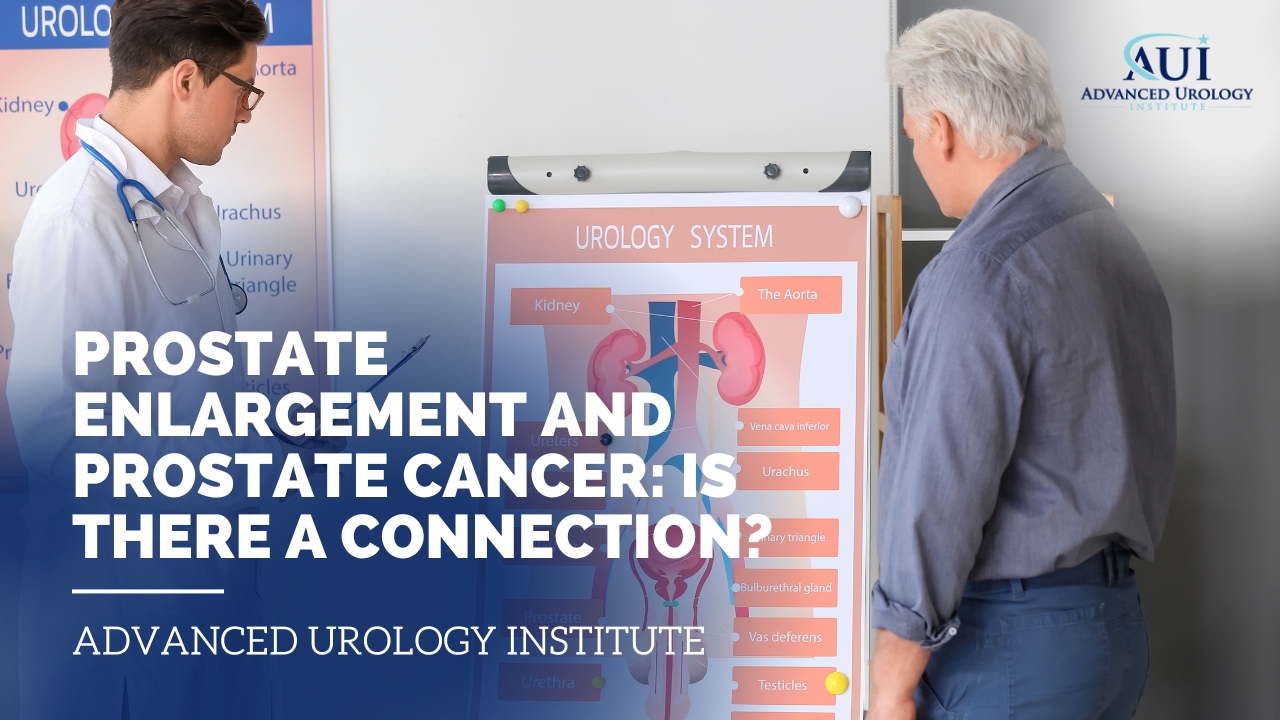Prostate Enlargement and Prostate Cancer: Is there a Connection?
Key Takeaways:
- Benign Prostate Enlargement (BPE) and prostate cancer are two distinct conditions, with prostate enlargement being noncancerous.
- Prostate enlargement and prostate cancer share similar symptoms and common risk factors.
- Prostate-specific antigen (PSA) levels increase in both conditions, with prostate cancer typically having higher levels. Early diagnosis is crucial for successful treatment.
 Benign prostate enlargement (BPE) is the medical term that describes an enlarged prostate, a common nuisance in aging men. In prostatic enlargement, also called benign prostatic hyperplasia (BPH), the central portion of the gland grows larger and presses against the bladder and urethra, slowing down or blocking urine flow. In turn, this leads to uncomfortable urinary symptoms, such as urinary frequency, often at night, or a weak urine flow.
Benign prostate enlargement (BPE) is the medical term that describes an enlarged prostate, a common nuisance in aging men. In prostatic enlargement, also called benign prostatic hyperplasia (BPH), the central portion of the gland grows larger and presses against the bladder and urethra, slowing down or blocking urine flow. In turn, this leads to uncomfortable urinary symptoms, such as urinary frequency, often at night, or a weak urine flow.
In contrast, prostate cancer occurs when cells of the prostate gland start to grow uncontrollably and turn into cancerous cells. The cancer tends to grow slowly compared to most other cancers, with cell changes usually beginning 10, 20, or even 30 years before the tumor is big enough to cause symptoms. Most prostate cancers never pose a problem, cause symptoms, or become a serious threat to health, but problems tend to appear when the cancer is advanced.
So, what is the connection between prostate enlargement and prostate cancer? Prostate enlargement is a noncancerous growth of the gland. It neither causes nor turns into prostate cancer, and is a completely separate condition. In fact, the risk of prostate cancer is lower in men with an enlarged prostate than in men without the condition. However, the two conditions are linked in various ways. Here are four ways in which BPH and prostate cancer are connected:
- They share similar symptoms: Shared symptoms between prostate enlargement and prostate cancer are a stronger urge to urinate, a regular need to urinate, trouble starting urination, a weak urine stream, interrupted urine flow, and an inability to fully empty the bladder. With prostate cancer, there may be hip and back pain as the cancer spreads or pushes on the spinal cord, but this is not seen in BPH, which primarily shows urination-focused symptoms as the growing gland narrows the urethra, causes bladder hypertrophy, and impedes urine flow. Also, a hard prostate may be an indicator of a nodule or tumor in some patients; the nodules and tumors may be benign or malignant, but having a hard prostate may also indicate noncancerous prostate stones, caused by chronic inflammation or BPH.
- Prostate enlargement is protective against prostate cancer: A recently reported connection between prostate enlargement and prostate cancer is that an enlarged prostate reduces the risk of the cancer. According to a study by Beaumont Health’s Radiology, Radiation Oncology, and Urology scientists, having BPH minimizes the risk of prostate cancer. Using prostate MRI, the scientists examined the prostate tissue in 405 men with an enlarged prostate. From the studied MRI data, BPH patients showed reduced risk of having prostate cancer. MRI is a noninvasive imaging without radiation and allows for an in-depth look at the anatomy of the prostate and shows differences in the inner and outer aspects of the gland.
- Both show elevated PSA: Prostate-specific antigen (PSA) is a protein secreted by the prostate gland. It is usually present in blood, but its level increases with age. PSA levels increase in both BPH and prostate cancer, but there is usually a greater rise in prostate cancer than in prostate enlargement.
- They share common risk factors: A number of risk factors trigger both BPH and prostate cancer. For instance, being overweight increases the risk of both prostate cancer and BPH. A man’s race and family history also determine his risk of both conditions. For example, African American men have a higher risk of BPH and prostate cancer than White American men. Likewise, a man with a father or brother who has had either BPH or prostate cancer has a greater risk of the condition. Prostate enlargement and prostate cancer are also both dependent on the testosterone hormone and respond to anti-androgen therapy.
When should you see a doctor? See a doctor as soon as possible if you have persistent, bothersome urinary symptoms. They could be an indicator of a more serious underlying condition, including BPH or prostate cancer. Remember, catching the cancer early is important for successful treatment. If your doctor finds that the symptoms are due to prostate enlargement, the treatment may involve medicines to shrink the prostate and alleviate symptoms or a surgical procedure to remove excess prostate tissue. On the other hand, prostate cancer is treated through an extensive, multidisciplinary approach that targets and destroys cancer cells and stops them from growing further. The treatment may involve surgical removal of cancer cells, radiation therapy, chemotherapy, or hormone therapy.
For more information on prostate enlargement, prostate cancer, and other urological problems, visit the site “Advanced Urology Institute.”

